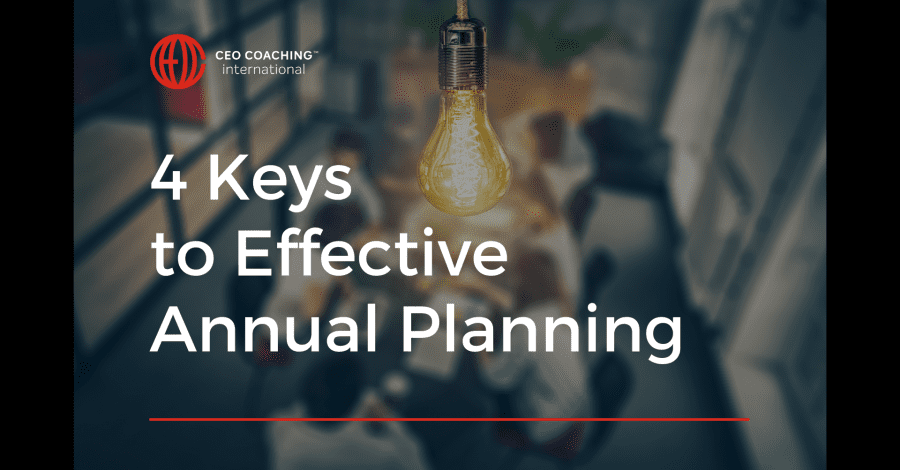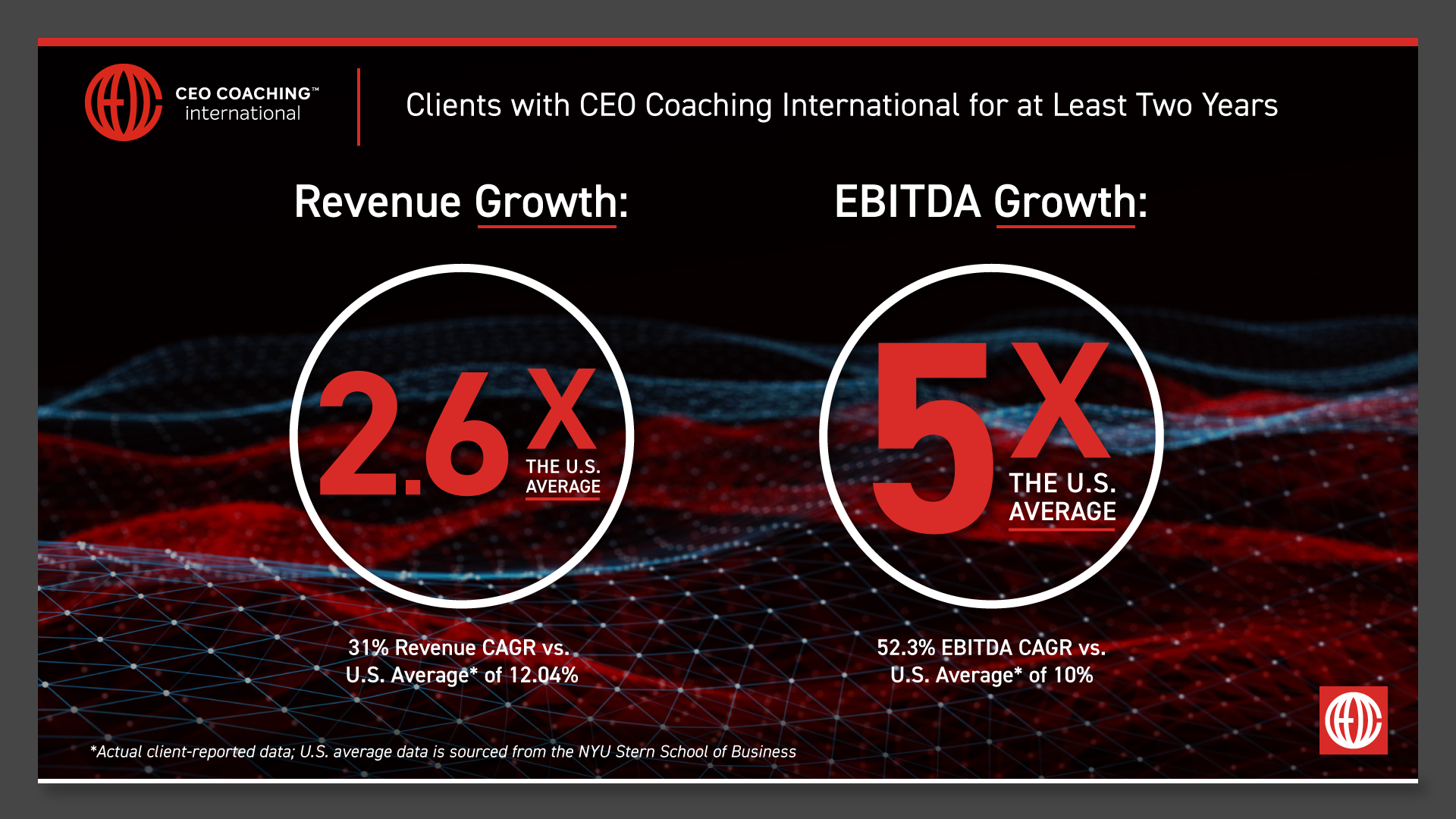
Click on the icons below to subscribe.
Guest: Greg Fricks, the co-owner of The Fricks Company, which specializes in the design, construction, and finishing of the most durable concrete floor surfaces in the world. Greg is also an entrepreneur coaching client of CEO Coaching International.
Episode in a Tweet: The before and after of an annual planning session are every bit as important as the session itself.
Quick Background: Effective annual planning may be the single biggest differentiator I’ve seen between companies that stay small and those that get BIG. But the very best CEOs understand that the building up to your planning session and maintaining your exit velocity afterwards are just as critical to growth.
On today’s show, Greg Fricks explains how his company implemented the annual planning process, the lessons they learned, and how this ongoing process has set them up for continued success.
Keys to Effective Annual Planning from Greg Fricks
1. Define your purpose.
If you’re new to the annual planning process, it’s important that you and your leadership team settle on the key objectives you want to accomplish before you even put this meeting on your calendar. The more focused your agenda, the more purposeful your meeting will be.
“As we were trying to grow our business, we realized that we needed to grow procedures and processes,” Greg says of the impetus for his first planning session. “We were trying to get the team focused and aligned on what we needed to work on and improve to grow our business for 2020 and beyond. We had many things that we wanted to work on and many things that needed to be worked on. But we lacked the focus as owners of the company. We lacked focus within the team and we were worried that we lacked buy-in from some team members.”
Frankly, repairing or maintaining alignment should be at the top of the planning list for any company. A CEO could distribute annual objectives with an email. The purpose of the annual planning session is to discuss how every layer of your organization is going to coordinate its efforts towards achieving those objectives. Your vision for company-wide alignment is going to determine both the agenda for the rest of this meeting and whom you want to attend.
2. Complete pre-work.
Many CEOs are reluctant to embrace annual planning because they’re picturing all of their employees packed into a hotel conference room for a week-long retreat. But for many companies, a smaller invite list makes for more effective planning. In fact, Greg thinks that one mistake he made with his first planning session was including too many employees.
One of the benefits of distributing pre-work ahead of a planning session is that you can hear from attendees and non-attendees alike to get a broad snapshot of every level of your company.
“There were some people that we wanted to get their input, but didn’t necessarily want them in the planning process,” Greg says. “So we sent out pre-planning session worksheets to everybody asking:
- What went right this year?
- What went wrong?
- If we were going to be the disruptor in our industry, what would we do? What would we not do?
- What would our competitor do to gain market share? What would our competitor not do?
- What areas of the company needed to be improved?
We were just trying to get everybody’s opinions as to what they felt needed to be worked on.”
Greg coordinated this process with his entrepreneur coach, Mike Marchi , who also facilitated the actual planning session. Working with Mike on both the pre-work questions and discussing his employees’ answers helped Greg gain some deeper insight on what his goals for the year should be.
“We have always considered ourselves an innovative company,” Greg says. “That’s one of the things that got us to where we are today and you can lose sight of what made you great to begin with. What came out of the pre-planning was that we hadn’t been innovative lately. We needed to start thinking about the future because what we’re doing today won’t necessarily work tomorrow. The pre-work brought focus back to that.”
3. Incorporate live feedback.
Mike started the two-day planning session by going through pre-work responses with the entire group. This discussion led to another important breakthrough for Greg and his partner, his brother Brad.
“Brad and I were too involved in the day-to-day activities,” Greg says. “We weren’t necessarily letting people spread their wings. We realized that within our crews, people weren’t climbing the ladder. They weren’t being trained to be better.”
This led Greg and Brad to add the development of a training matrix to their key annual objectives. The brothers also were receptive to feedback from team leaders about prioritizing certain goals and delaying others.
“After going through the pre-work, everybody got to list what they thought were the most important objectives,” Greg says. “Then we whittled that down. Some of them were combined, some were eliminated. Some of them were put on the back burner for the following year, but we identified what were the six major objectives that we needed to work on in 2020 to improve our company. Then we identified who the owners of each objective were going to be. By the end of the second day, we all knew what each person needed to do to be successful and how we could all support each initiative, not just the ones we were signed up for.”
4. Build a year-round accountability system.
The most important part of an annual planning session isn’t the planning session. It’s what happens next. Dreaming BIG, setting goals, and assigning responsibility can be easy. Heck it can even be fun, especially when you and your team leaders are all energized by your shared vision and excited to make it happen.
But hitting those daily, weekly, monthly, and quarterly targets takes hard work. That’s why it’s so critical that you have best practices in place that will help your team maintain the focus and momentum you built in your planning session.
“We developed a pretty elaborate spreadsheet that showed each objective and explained what the intent was and what we’re trying to achieve,” Greg says. “It listed all the players that were on the team for each individual objective, a start date, and an end date. As long as it was being worked on and we hadn’t missed the completion date, then that objective stayed in the blue, meaning active. Red meant that we’d missed the deadline. Green meant that it was completed.”
To keep those blue items turning green, Greg also maintained a strong meeting rhythm that ramped up a couple beats as important deadlines neared. It’s this combination of annual planning and year-round accountability that separates good companies from BIG companies that keep getting bigger.
“The planning session helped us identify areas in the market that we need to focus on,” Greg says. “It’s helped us identify where we as a company need to focus on our procedures within our four walls, where we’re weak and where we’re strong, what we needed to maintain and what we needed to build up. It’s helped us be a much more organized, strategic, and productive company in the day-to-day processes.”
Top Takeaways
1. Plan for your annual planning session or the meeting itself won’t be effective.
2. Execute your planning agenda with a third-party facilitator who can help keep the meeting focused.
3. Follow through on your annual plan by making accountability an integral part of your best practices and your culture.
About CEO Coaching International
CEO Coaching International works with CEOs and their leadership teams to achieve extraordinary results quarter after quarter, year after year. Known globally for its success in coaching growth-focused entrepreneurs to meaningful exits, CEO Coaching International has coached more than 1,000 CEOs and entrepreneurs in more than 60 countries and 45 industries. The coaches at CEO Coaching International are former CEOs, presidents, or executives who have made BIG happen. The firm’s coaches have led double-digit sales and profit growth in businesses ranging in size from startups to over $10 billion, and many are founders that have led their companies through successful eight, nine, and ten-figure exits. Companies working with CEO Coaching International for two years or more have experienced an average revenue CAGR of 31% (2.6X the U.S. average) and an average EBITDA CAGR of 52.3% (more than 5X the U.S. average).
Learn more about executive coaching | Meet our world-class coaches









